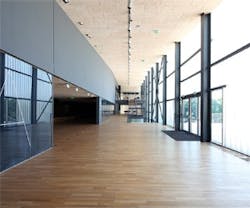The salt and sand that accompany winter snow and the mud that comes with spring rain can leave your hardwood floor in dire need of refreshment.
Unless you want your floors to look ravaged by the elements (and who would?), you have two choices: replace or refinish. Higher costs and disruption are associated with completely replacing your hardwood floors, so opting to refinish them may be a more economical solution.
These refinishing methods haven't changed much over the years. The process includes sanding the floor multiple times before thoroughly vacuuming and cleaning the area, and then applying a series of finishing coats with time to dry in between and after. It's a long and messy task.
However, with the use of truck mount and portable vacuum systems, dust containment has improved, which nearly eliminates airborne dust problems. The recent development of water-based polyurethanes has also changed the industry. These products have lower VOCs, dry/cure in less time, and dry harder (for greater durability) than oil-based products, which don't dry as fast or hard but are less expensive.
Condition of Coatings
So how do you know if it's time to refinish your floors?
"The telltale signs of how often floors should be refinished are that you're getting areas of discoloration because the wear is going through the coatings that are on the floor," explains Gareth Higgins, president of Higgins Floors, LLC.
Your current flooring maintenance plans will impact the condition of your floors and how often they should be refinished.
"It really comes down to the current process in which the floor is maintained," explains Ryan Ditsch, national hardwood manager of Stanley Steemer. "Vacuuming on a daily basis, cleaning the floor with non-residual cleaning products, walk off mats, and monthly and/or quarterly professional cleaning all play an intricate role in determining how often a non-residential wood floor should be refinished."
Your Floor Plan
The condition of your entire floor will also play a part in determining whether it's time to refinish. A particularly worn spot in a highly trafficked or prominent area – like a main hallway – may beg to be refinished, but lower trafficked, out of the way areas – like private offices – may be able to wait another year. What should you do?
The answer lies within your floor plan. Is the entire floor continuous? Is consistency of the floor's appearance important?
"If there's separation between the hallway and the office, then you could just do the hallway," explains Higgins. "But if you have a floor plan where the hallway hardwood floors and the office hardwood floors run together, then you will have to do the entire area just because there's no real way to feather or fade in open floor plans. You have to do the whole area just to have a consistent look."
If consistency is key, you'll want to have the entire floor refinished at the same time – whether that means including what doesn't yet need to be redone or opting to wait until the entire floor could use refinishing.
However, you can refinish only the areas that need it most. Just know that there will be a contrast between the areas you're refinishing and the areas you aren't.
Care is Key
You can't prevent your hardwood floors from needing to be refinished –
all hardwood floors will eventually need to undergo this process. But proper care will give your floors a longer life between refinishings.
"Make sure all customers remove their shoes before walking on the wood floor, vacuum every day, and clean the floor with a non-residual solution," says Dietsch. Some of these recommendations are more realistic than others.
"Vacuuming the floor every day and cleaning with approved solutions are realistic options for any facility manager, but asking the general public to take their shoes off is not," he says. "Eventually, all non-residential settings will require additional applications of polyurethane."
Kylie Wroblaski ([email protected]) is associate editor of BUILDINGS.
